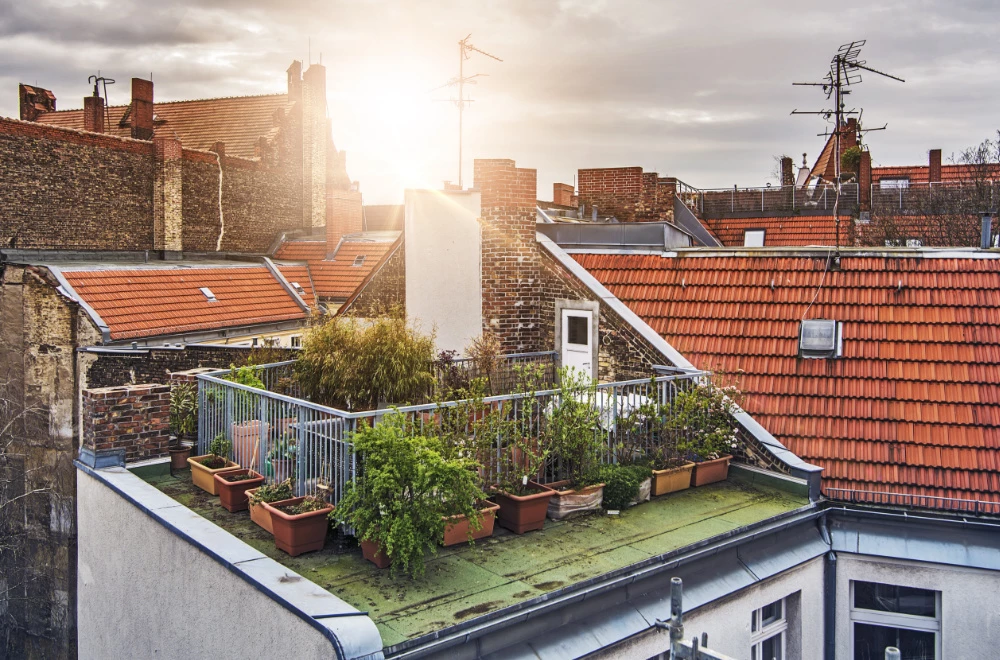Urban gardening has really become a buzzword lately. But what does it actually mean? And where can I garden anywhere in the city? In this article, I want to give you an overview of the different forms of urban gardening and provide a few ideas on where you can start gardening yourself.
Contents
The obvious solution: the balcony garden
The term “urban gardening” can be used to describe many forms of gardening in the city. But anyone thinking about gardening in the city is likely to come up with the classic balcony or roof terrace garden fairly quickly. Here, people garden in pots and balcony boxes, tubs and raised beds. As an avid balcony gardener, I can tell you: there’s something to be said for being in the “garden” in two steps from your bed.
A big advantage is that the balcony garden is as close to home as it gets. So it’s very easy to take care of the plants and give them enough attention. Besides, from the kitchen you are super fast in the “living pantry” to cook the fruits of your labor as needed. It’s really amazing how many vegetables can be grown even in a small space. So if you have a balcony or a roof terrace and don’t garden there yet, you should start as soon as possible – it’s worth it!

For those without a balcony: the window sill
There is one catch to balcony gardening: you need a balcony. Unfortunately, only a fraction of city dwellers are granted this blessing. But don’t worry – even without a balcony, you can live out your botanical fantasies in a variety of ways. With a bright windowsill, you can already do quite a bit. At least a few kitchen herbs or a small chili plant will definitely find a place here. A hot tip for windowsill gardeners are “microgreens” or sprouts. Seeds of e.g. radishes or cabbage varieties are brought to germinate and then harvested after a few days. The sprouts make great toppings for salads or like cress on a sandwich.
If you also want to garden indoors on a large scale or want to save your treasures from the balcony over the cold season, it might be worthwhile for you to purchase a plant light. In the meantime, LED lamps are available at relatively low prices, which give life to your plants and consume surprisingly little electricity. However, it is still most environmentally friendly to be outside in the sun, so think about whether artificial light is really necessary for your purposes, or whether there is another alternative.
Better Together Than Alone: The Community Garden
The forms of urban gardening described so far work well in your home. But as with so many things, gardening is much more fun when you do it together. That’s why there are now a rapidly growing number of urban community gardens in most cities. Many of these projects occupy brownfields and otherwise unused land, transforming these places into oases of green in the midst of all the gray.
In a community garden, you can not only meet nice people who share your hobby, but also benefit from the experience of others and learn much faster than trying to figure it all out on your own. To find a community garden near you, the Internet is your friend: many of the projects can be found on Facebook or Instagram, or even have their own website.

The classic: the allotment garden
If one had to sort the various forms of gardening on a timeline, the modern community garden would probably be the successor to the classic allotment garden. But even today, there are a large number of allotment garden associations where you can lease a small plot of land, often for very little money. In many cities there are allotment garden sites that are much more centrally located than you might think. And an allotment garden is the ultimate ticket to really getting into the gardening business. However, you also make a big commitment. Especially in the summer, the garden may require daily maintenance, depending on how it is planted. Whether you are willing to make this commitment is something you should consider beforehand.
Gardening as a form of action: Guerilla Gardening
Last but not least we come to a more “radical” form of gardening. Now you might ask yourself: radical gardening, how is that supposed to work? But the so-called “Guerilla Gardening” has exactly this claim: Gardening everywhere, where the ground is not sealed by asphalt or concrete. The classic example of guerrilla gardening is seed bombs. Here, seeds are mixed with soil and clay and formed into balls that can then be spread on green strips and tree grates. Some guerrilla gardeners go a little further, for example in Berlin. There, in some neighborhoods, you can find entire vegetable gardens along the edge of sidewalks under trees.
We think: Guerilla Gardening is a great thing. After all, why should all green spaces consist only of lawns when useful plants could also grow there? But there’s a catch: some city councils don’t like it when you turn their meticulously laid out green spaces into wild permaculture experiments. In case of doubt, the public order office may intervene. So think beforehand how far you want to go with your actionism and maybe just ask the city or district administration if there are areas where Guerilla Gardening is okay. In Stuttgart, for example, there is now a special office for urban gardening projects at the city, which you can contact with such concerns.
Even though gardening has long since arrived in the inner cities these days, we think: Everything could be much greener. Because nothing is as depressing as the dreary surroundings of a gray concrete desert. So if you haven’t already, pick your form of play and start gardening! You can’t lose. And if you need help, there’s always Fryd.


